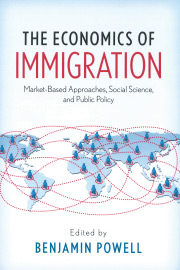During the past five years more new immigrants came to the United States than ever before in our history—nearly 8 million, according to a new study by the Center for Immigration Studies. This influx has stirred much public debate. But before we adopt new policies, politicians need to distinguish clearly between the real problems caused by immigration and non-problems based on popular myths.
Probably the number one misconception about immigration is that it harms our economy. In reality, conservative estimates put the net gain to the U.S. economy from current immigration at about $20 billion. Instead of recognizing this overall gain, immigration critics typically claim that immigrants take away American jobs, depress wages and drain our tax dollars by consuming social services.
A fundamental truth about our economy is that as long as we desire more goods and services than we have, the number of jobs is practically unlimited. In fact, when we have more workers, we create more jobs. Total employment and the size of the labor force have tracked each other fairly closely over the past 50 years despite dramatic changes in immigration flows.
It’s a well-known fact that many of the jobs immigrants come here to fill are jobs Americans are not taking. And when we prevent immigrants from taking those jobs, American producers and consumers suffer the consequences. For example, due to labor shortages caused in part by increased border controls, only 30 percent of last fall’s lettuce crop in Arizona was harvested. Losses were nearly one billion dollars. There simply were not enough U.S. workers willing to pick the crops at prices that would have made it profitable.
Less well known is that many jobs immigrants take are jobs that would have otherwise been outsourced. Nearly one-third of U.S. garment workers are immigrants. Increasingly, we are turning to international trade to secure our clothing. If it were not for immigration we’d likely be importing even more clothing. Similarly, in high-skill occupations, such as software engineering, when companies are not allowed to bring immigrants to America, they send the job to the worker. Microsoft’s Bill Gates has said that eliminating caps on H1-B visas would encourage his company to outsource fewer jobs.
What about wages? Immigration increases the supply of domestic labor. Basic economic reasoning shows that when you increase the supply of any good, holding other things constant, its price should go down. However, immigration brings many secondary effects that offset the increased supply. Most immediately, when immigrants earn money, they demand goods and services. This increases the demand for labor, which in turn creates more jobs and pushes wages back up.
A less obvious, but no less important, consequence of immigration is that with a greater supply of labor, more goods and services are produced. This leads to lower prices, and an increase in the purchasing power of existing American wages. Finally, a larger labor force can raise the profitability of capital investment. If increased capital flows match the increased labor force, wages are not pushed down. Even Harvard economist George Borjas, a prominent critic of immigration, admits that if the capital stock increased enough to keep returns constant, immigration would not lower the earnings of natives on average.
The secondary consequences of immigration are born out in the professional economics literature. A comprehensive survey of the immigration literature, published in the Journal of Economic Perspectives reached the following conclusion: “Despite the popular belief that immigrants have a large adverse impact on the wages and employment opportunities of the native-born population, the literature on this question does not provide much support for the conclusion.”
The economic case for open immigration is not fundamentally different than the case for free trade or free capital mobility. Allowing goods and services, capital, and labor to flow freely allows them be channeled to their most efficient uses and brings overall benefits to the domestic and world economies.
The objection that immigration costs tax dollars has some merit. Since many of the tax-funded services immigrants consume are funded at the local level and much of the taxes that immigrants pay goes to the federal government, immigration is a tax burden on some communities. This is fundamentally a problem of public policy, not economics. Policy reforms could fix this by decreasing the social services that immigrants and their children are eligible to consume.
We need not fear that immigrants will burden our economy, take more jobs than they create, or depress our wages. Quite the contrary, immigration brings economic benefits, so it should not be artificially limited. Current guest worker proposals by President Bush and the Senate do not go far enough. A truly beneficial reform would concentrate on creating an open immigration policy while dealing with real problems that increased immigration could bring. This would involve limiting entitlement spending and may require more restrictions on immigrants’ ability to eventually vote.











